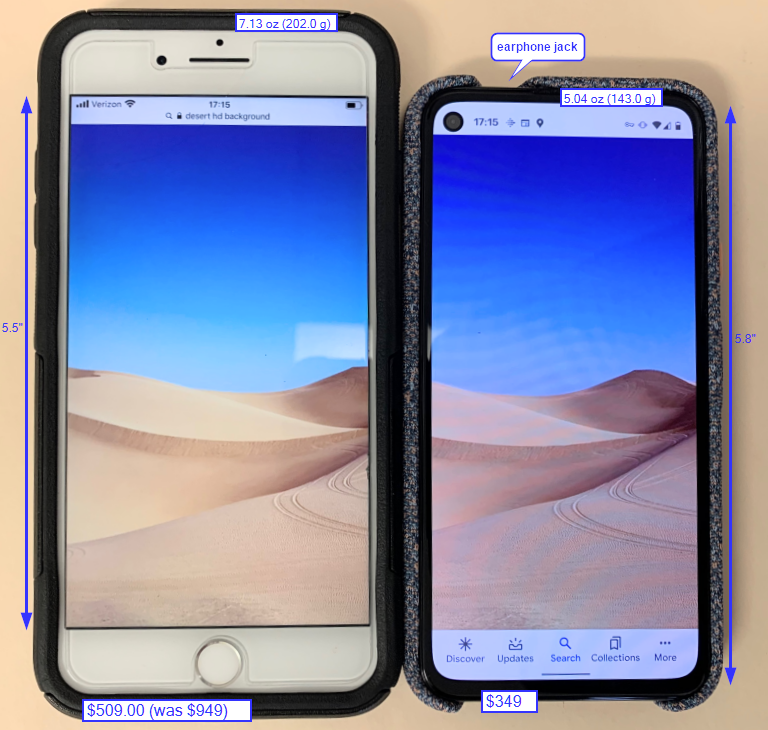I regret giving up my Pixel 4a
Intro:
I read “There are too many iPhones” from @gr36 this morning, which got me to vent. I went into my old archives and dag out my post about the Pixel4a, A phone I stupidly sold to get the Pixel 6, which I regret getting (too costly, too Google, and of course, too damn big).
This is the old post from 2020-08-27. Almost everything I say in it is relevant today, including wanting to go into GraphineOS.
I received my new Pixel 4a a Friday before last and after a week I can say this with confidence: this is the best smartphone Google ever made. I also hope it will be the last phone I buy from Google.
If you want to read more about the Pixel4a, There are plenty of reviews on the web, both written and videos (here’s a recent in-depth one from arstechnica, and a quicker video from the Verge). Here I’m going to focus on why I like this phone.
Hardware: The Phone
Let’s start with the obvious: the price. At $350, Google is back where it has always been best: supplying top tech at a price that doesn’t twists people’s arms. At hard times like this, with folks losing their jobs, this is a welcome change from the $800-plus flagships.
The Pixel 4a is not a statement of class like the iPhone, and it’s far from delivering the latest and greatest. That’s fine because I don’t need the latest and greatest, I need a damn phone. The iPhone 8 Plus, which I have for work, still sells for about $500 today(1)
The iPhone 8 Plus is too heavy and too big, yet somehow the screen on it is smaller than the one on the Pixel 4a. This makes a big difference. The Pixel doesn’t fall out of my hand when I pick it up like the iPhone 8 Plus does. I can reach the corners of the screen without doing crazy hands acrobatics. It doesn’t stick out of my pocket for everyone on the street to see. It fits into my pouch when I go for a run. These may look like insignificant details, but the overall experience is liberating.
As a bonus, the pixel comes with an earphone jack. I can carry my FLAC files with me on the phone and listen to my higher-end earphones at the office now. The Bluetooth headphones are good for meetings and streaming music, but if I want to get lost in some good stuff, I need an audio cable(2). It’s also nice to plug in my good set and charge my phone at the same time when I’m at my computer.

I know the argument for/against Pixel phones is all about the camera, the better battery life, lack of better water resistance, Android sucks/rules, blah blah blah. I don’t care about those. While I don’t particularly care about looks, the Pixel does look nice. The edge-to-edge screen without bezels, the crisp image, and the fabric cases to match, it puts the iPhone in perspective.
The software (Android)
I used to marvel at Google’s utilitarian vanilla Android and scoff at anything that isn’t a pure Android experience. Now, after a couple of years in IT working with Android, iOS, macOS, Windows, and of course Linux, I’m moving forward.
It’s called GrapheneOS. A mobile OS that strips the Pixel from what makes it Google. It’s a mobile OS built for privacy geeks who want a smartphone that doesn’t call back to the mothership. I want to wipe this phone clean and see if I can live without Google on me all the time.
But I’m cheating. I still have my iPhone. I’ve decided that all the apps that need to “spy” on me can be on my work phone. Bank app? I don’t mind if my job, which pays my salary, sees my bank statements. Google Maps? If I travel, I can’t leave work completely behind anyway. Phone calls? I barely call people anymore and most of my contacts are on iPhone, so I don’t mind using Facetime. Everything private however will live on the Pixel. My org notes in Orgzly, my contacts on Signal(3), my media, passwords, etc.
Right now, this is a challenge I want to take. I still have my old Pixel 2, and I’m planning to use it first as a “demo” version to see how this works out - or fails. By the time I’m done, I believe GrapheneOS will already have a working Pixel 4a version.
Why? Well, why not? This blog is called the art of not asking why, after all.
Footnotes
(1) This price came up for a refurbished iPhone 8+ on Apple’s website.
(2) I find that I don’t need my amplifier when I connect directly to the jack. With the USB-C dangle, which looks terrible and prevents charging at the same time (so the phone slowly runs out of juice), I need to use an AMP as well. Visualize this: an audio cable from the headset goes into an adapter, which goes into the AMP, which goes into the phone. I want to say there’s a slight difference in sound quality without the amp, but I don’t have a professional-grade headset to detect that sort of thing.
(3) This will be tricky since Signal is not exactly open source, but I’m aware there’s a way to install the APK anyway. Actually, Signal puts out its APK on its website.
